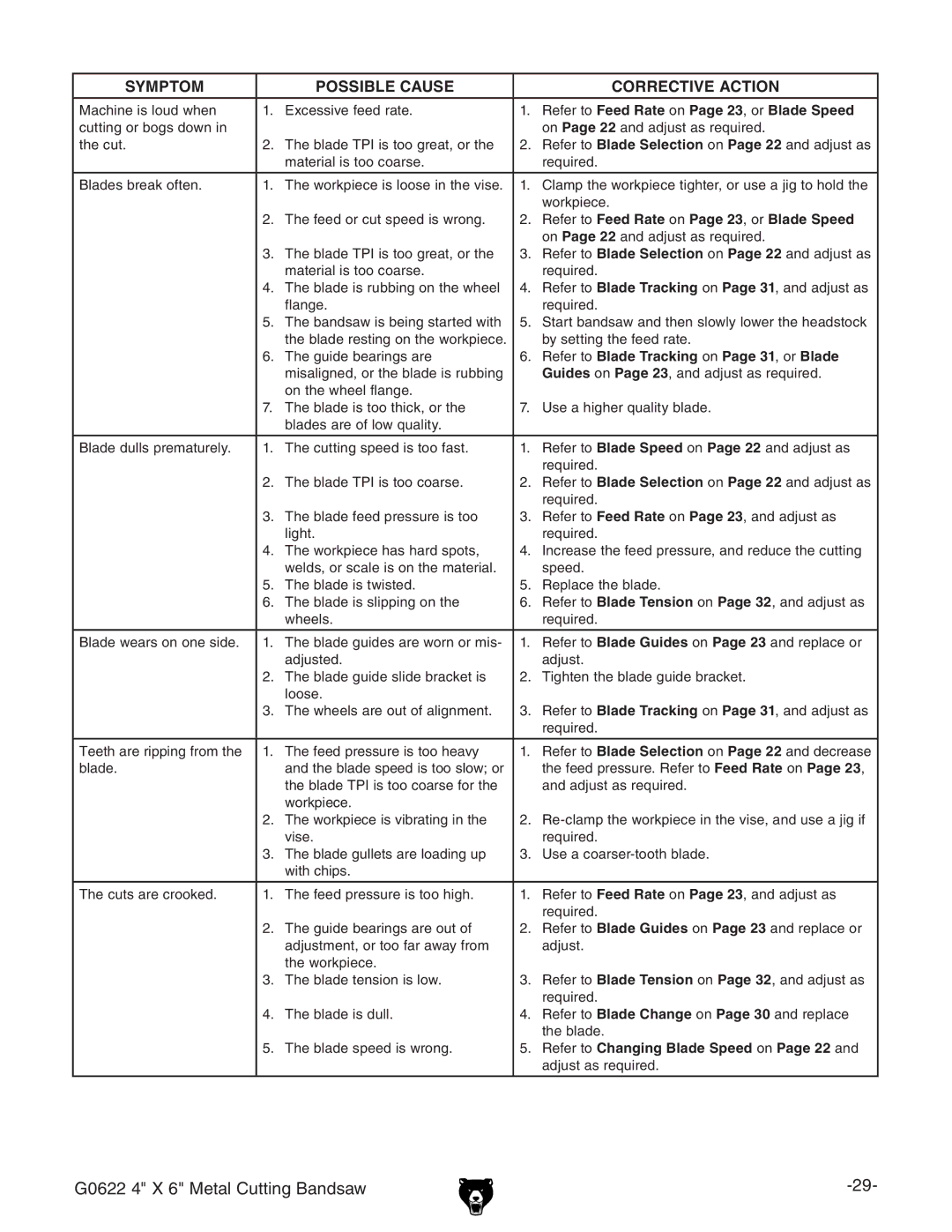SYMPTOM |
| POSSIBLE CAUSE |
| CORRECTIVE ACTION |
Machine is loud when | 1. | Excessive feed rate. | 1. | Refer to Feed Rate on Page 23, or Blade Speed |
cutting or bogs down in |
|
|
| on Page 22 and adjust as required. |
the cut. | 2. | The blade TPI is too great, or the | 2. | Refer to Blade Selection on Page 22 and adjust as |
|
| material is too coarse. |
| required. |
|
|
|
|
|
Blades break often. | 1. | The workpiece is loose in the vise. | 1. | Clamp the workpiece tighter, or use a jig to hold the |
|
|
|
| workpiece. |
| 2. | The feed or cut speed is wrong. | 2. | Refer to Feed Rate on Page 23, or Blade Speed |
|
|
|
| on Page 22 and adjust as required. |
| 3. | The blade TPI is too great, or the | 3. | Refer to Blade Selection on Page 22 and adjust as |
|
| material is too coarse. |
| required. |
| 4. | The blade is rubbing on the wheel | 4. | Refer to Blade Tracking on Page 31, and adjust as |
|
| flange. |
| required. |
| 5. | The bandsaw is being started with | 5. | Start bandsaw and then slowly lower the headstock |
|
| the blade resting on the workpiece. |
| by setting the feed rate. |
| 6. | The guide bearings are | 6. | Refer to Blade Tracking on Page 31, or Blade |
|
| misaligned, or the blade is rubbing |
| Guides on Page 23, and adjust as required. |
|
| on the wheel flange. |
|
|
| 7. | The blade is too thick, or the | 7. | Use a higher quality blade. |
|
| blades are of low quality. |
|
|
|
|
|
|
|
Blade dulls prematurely. | 1. | The cutting speed is too fast. | 1. | Refer to Blade Speed on Page 22 and adjust as |
|
|
|
| required. |
| 2. | The blade TPI is too coarse. | 2. | Refer to Blade Selection on Page 22 and adjust as |
|
|
|
| required. |
| 3. | The blade feed pressure is too | 3. | Refer to Feed Rate on Page 23, and adjust as |
|
| light. |
| required. |
| 4. | The workpiece has hard spots, | 4. | Increase the feed pressure, and reduce the cutting |
|
| welds, or scale is on the material. |
| speed. |
| 5. | The blade is twisted. | 5. | Replace the blade. |
| 6. | The blade is slipping on the | 6. | Refer to Blade Tension on Page 32, and adjust as |
|
| wheels. |
| required. |
|
|
|
|
|
Blade wears on one side. | 1. | The blade guides are worn or mis- | 1. | Refer to Blade Guides on Page 23 and replace or |
|
| adjusted. |
| adjust. |
| 2. | The blade guide slide bracket is | 2. | Tighten the blade guide bracket. |
|
| loose. |
|
|
| 3. | The wheels are out of alignment. | 3. | Refer to Blade Tracking on Page 31, and adjust as |
|
|
|
| required. |
|
|
|
|
|
Teeth are ripping from the | 1. | The feed pressure is too heavy | 1. | Refer to Blade Selection on Page 22 and decrease |
blade. |
| and the blade speed is too slow; or |
| the feed pressure. Refer to Feed Rate on Page 23, |
|
| the blade TPI is too coarse for the |
| and adjust as required. |
|
| workpiece. |
|
|
| 2. | The workpiece is vibrating in the | 2. | |
|
| vise. |
| required. |
| 3. | The blade gullets are loading up | 3. | Use a |
|
| with chips. |
|
|
|
|
|
|
|
The cuts are crooked. | 1. | The feed pressure is too high. | 1. | Refer to Feed Rate on Page 23, and adjust as |
|
|
|
| required. |
| 2. | The guide bearings are out of | 2. | Refer to Blade Guides on Page 23 and replace or |
|
| adjustment, or too far away from |
| adjust. |
|
| the workpiece. |
|
|
| 3. | The blade tension is low. | 3. | Refer to Blade Tension on Page 32, and adjust as |
|
|
|
| required. |
| 4. | The blade is dull. | 4. | Refer to Blade Change on Page 30 and replace |
|
|
|
| the blade. |
| 5. | The blade speed is wrong. | 5. | Refer to Changing Blade Speed on Page 22 and |
|
|
|
| adjust as required. |
|
|
|
|
|
G0622 4" X 6" Metal Cutting Bandsaw |
